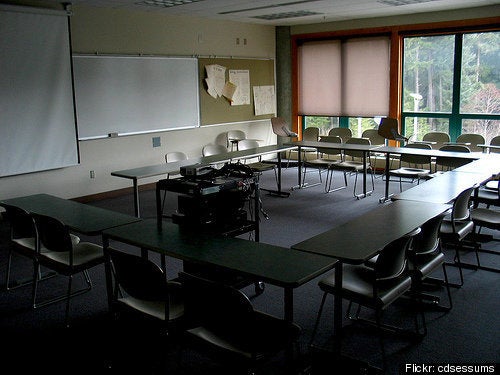
Is America ready to settle for a great education -- for the few? That's the question at the heart of Blaise Nutter's paean to the forthcoming documentary from director Davis Guggenheim, Waiting for Superman.
Nutter's review, like the movie, is selective and incomplete, which is not surprising. A cottage industry has sprung up around pundits who have little substantive knowledge about public education, but opine away nonetheless. For instance, Nutter never challenges one of the major shortcomings of the film: that Guggenheim chose to include footage of a bad teacher in a Milwaukee classroom and the rubber room in New York, but opted not to include footage of successful public schools where uncounted and unheralded teachers are doing extraordinary things every day to teach our children. This lack of balance may suit Guggenheim's narrow and selective narrative, but it does not tell the full and textured story of what actually is going on in American schools.
The documentary calls attention to the children who are being failed by our education system and deprived of the kind of education that will open doors for them throughout their lives. Despite Guggenheim's undeniably good intentions, the film falls short by casting two outliers in starring roles -- the "bad" teacher as villain, and charter schools as heroes ready to save the day. The problem is that these caricatures are more fictional than factual.
Are there bad teachers? Of course there are, just as there are bad accountants, and lawyers, and film reviewers. I wish there weren't any bad teachers. But Nutter ignores that the AFT is in the forefront of developing and implementing ways to improve teacher quality, and to deal effectively and efficiently with problems when they occur.
In fact, union-led teacher assistance and review programs (in which new and struggling teachers are coached and evaluated by more experienced peers) have been shown to be far tougher on poorly performing teachers than those conducted by administrators.
Nutter betrays his naivete when he writes: "Everyone agrees that the main problem with schools is bad teachers; but tenure, built into the unions' contracts, prevents schools from getting rid of them." Ahem. No teacher -- myself included -- wants teachers in the classroom who don't belong there. Those knowledgeable about education understand the importance of teacher quality, but they don't buy into the simplistic notion that an epidemic of "bad teachers" is bringing down an otherwise thriving enterprise of education.
And tenure should never be misconstrued as a "job for life." Teachers and teachers unions are right to preserve a fair, objective standard by which teachers should be judged. But due process must not disintegrate into glacial process, and teachers who -- at the end of a fair, efficient process -- are deemed unfit for the profession should be dismissed. Administrators also must fulfill their responsibilities: to support, properly evaluate and, when necessary, make tough decisions about the teachers entrusted to educate our children.
I could litter a cutting room floor with all the snippets Nutter gets wrong. For example, New York City's rubber room has been closed, after years of union-led efforts to slam the door on this practice. And, while Waiting for Superman may be light on solutions, Nutter's blog post is confident in its expertise. "We already know what we have to do," our movie-reviewer/education expert writes. "Hire and keep good teachers, set high standards of achievement, and incorporate ideas from the best performing schools."
For argument's sake, let's say a miracle happened overnight and our current, completely inadequate system of evaluating teacher effectiveness suddenly became adequate or, better yet, accurate. Say administrators identified teachers who simply didn't make the grade, and removed them from their classrooms. What then?
Who wants to deal with the more complicated (but less sexy) and absolutely necessary (but unexciting) realities, such as the fact that teachers need tools, resources and support to do their jobs well? It's cathartic to say "fire the bad teachers," but it doesn't do much to improve schools. The plain, unsexy fact is that the best way to improve teacher quality is to do a better job of developing and supporting the teachers to whom we entrust our children's educations.
And Nutter seems to buy into the world-according-to-Superman philosophy of education reform -- that the "best performing schools" are the boutique schools that enjoy extra resources and are more selective in choosing their student populations. I mean no disrespect to the many well-intentioned people who set out to provide a good education to students who have been denied that right. But most of them fall short, and even those who defy the odds touch only a minuscule percentage of students.
The opportunity for a great public education should come not by chance, not even by choice, but by right.
We all agree that right is being denied to too many children. But, in the end, no solution is as scalable, as accessible or as accountable as a great neighborhood school. I've seen such success stories in real life. In schools everywhere from New York City to Albuquerque, N.M., from St. Paul, Minn., to Philadelphia, and from Los Angeles County to Baltimore, students are defying the odds. The solutions aren't the stuff of action flicks--supports for disadvantaged students, extra help for those who start or fall behind, high expectations for all students and challenging coursework -- but they achieve the desired results.
Imagine a sequel to Waiting for Superman, released a few years from now. Would we rather stick with the cinematic model of providing an escape hatch -- sometimes superior, most often inferior -- to a handful of students? Or offer a model in which we had summoned the will to do the hard, but effective and far-reaching, work to make meaningful changes to entire school systems, providing all children with the best possible choice -- a highly effective neighborhood school?
Ninety percent of American students -- nearly 50 million children -- attend our public schools. Change in a single classroom, a single school, or even a single school district is not enough.
We cannot wait. And we must not hinge our hopes on Superman, or on any mythical solution or silver bullet. We cannot depend on anything other than replicable, scalable, effective ways to provide all children the education they deserve.
